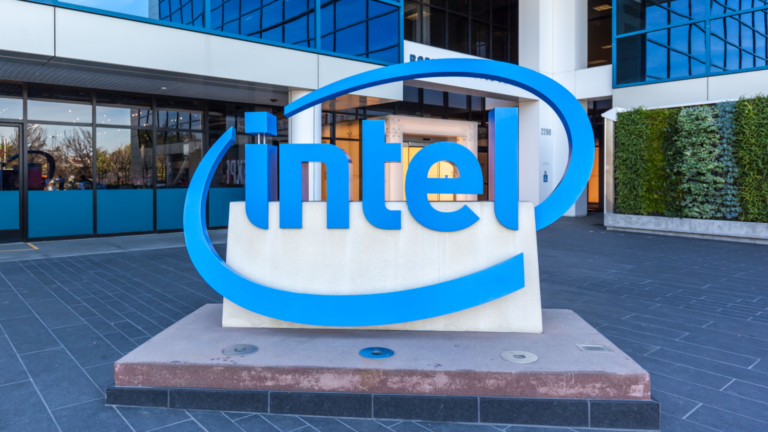Don’t sleep on Intel (NASDAQ:INTC) even though Intel stock is clearly overshadowed by rivals Nvidia (NASDAQ:NVDA) and AMD (NASDAQ:AMD) in the high-performance computing world.
When Intel announces the launch of its Intel 20A and Intel 18A investors will have something to get excited about.
Known as one of the biggest semiconductor companies in the world, Intel has received support from the Science Act and the CHIPS Act. This strong government support highlights the company’s pivotal standing in the innovation-focused semiconductor tech sector.
Collaborations with industry giants like Microsoft, Dell, and Roche underscore Intel’s leading position and potential for market expansion in the AI-driven economy.
Earnings for Intel stock have declined consistently since 2021, but are stabilizing with an 8.6% revenue increase year-over-year.
Despite a year-to-date stock drop of more than 35%, analysts project more than 30% upside from current levels. At this point, the stock appears to have some strong risk-reward upside, if you believe the forward numbers.
Huawei and Intel Stock
According to sources, the U.S. revoked licenses enabling Intel and Qualcomm to supply chips to Huawei. Some companies were notified on Tuesday. The Commerce Department confirmed license revocation without naming specific firms.
Intel’s spokesperson refrained from commenting, while Qualcomm and Huawei stayed silent. The Commerce Department revoked licenses post-Huawei’s MateBook X Pro launch with Intel’s Core Ultra 9 processor.
Republican lawmakers objected to this move, implying Commerce permitted Intel’s chip supply to Huawei. Commerce confirmed license revocation under pressure from China critics, praised by Congresswoman Elise Stefanik for boosting national security and countering China’s tech advancement.
The action may affect Huawei, dependent on Intel chips for laptops, and U.S. suppliers dealing with the company.
The Chinese foreign ministry criticized the move as unjustified. Intel faces weak demand for traditional chips, losing $11 billion in market value last month because of lower-than-expected revenue and profit forecasts.
Japanese Team Targeting Chip Automation
Intel partnered with 14 Japanese companies, including Omron and Yamaha Motor, to automate back-end chipmaking processes like packaging.
The Japan team is led by Kunimasa Suzuki, and the group plans to invest billions of yen for the project. Intel aims to mitigate geopolitical risks in the chip supply chains.
As front-end advancements near physical limits, competition in back-end processes like chip stacking intensifies. Manual assembly, prevalent in labor-rich countries, drives the push for automation in higher-cost regions like the U.S. and Japan.
Intel’s group plans a trial automated back-end production line in Japan, aiming for full automation and standardized technology management.
Japanese companies control 30% of global semiconductor equipment sales and 50% of materials, per Japan’s Ministry of Economy, Trade, and Industry.
The ministry plans to support with billions of yen from a 4 trillion yen fund for economic security. To reduce dependency on China, holding 38% of back-end chipmaking in 2022, Japan and the U.S. incentivize local production.
Systems Foundry for AI
Intel unveiled Intel Foundry, a sustainable systems foundry for the AI era, with an expanded road map. Partnering with Synopsys, Cadence, Siemens, and Ansys, it accelerates chip designs. Industry leaders Gina Raimondo, Rene Haas, and Satya Nadella shared insights at the inaugural event.
Intel CEO Pat Gelsinger highlighted AI’s transformative power, emphasizing Intel Foundry’s role in shaping the future. The extended road map includes Intel 14A and specialized node advancements, maintaining the 5N4Y plan on track. Intel aims to lead with Intel 18A by 2025.
The updated road map includes advancements for Intel 3, Intel 18A, and Intel 14A technologies. Notable is Intel 3-T for 3D advanced packaging. Mature process nodes like 12nm, developed jointly with UMC, aim to meet specific customer requirements.
Intel Foundry plans a new node every two years, ensuring continuous evolution for customers. Intel expands its ASAT offerings with Intel Foundry FCBGA 2D+.
On the date of publication, Chris MacDonald did not have (either directly or indirectly) any positions in the securities mentioned in this article. The opinions expressed in this article are those of the writer, subject to the InvestorPlace.com Publishing Guidelines.

